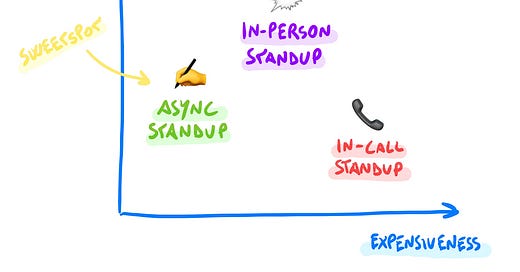When I joined Translated last September we created a new product team dedicated to internal tools.
It is a small team — four people — devoted to improving lives of the 40+ Account Managers & Project Managers working in the company.
Early on we spent a few weeks collecting requirements, prioritizing features, and laying a bit of groundwork for the development process.
☀️ Daily Stand-ups, in person
We did this at the office, and among other things we had daily stand-ups first thing in the morning. Stand-ups have always served us well, in particular:
🚫 They make sure there are no blockers.
🎯 They make people commit on daily goals, which has a positive effect on their motivation.
🤗 They provide a sense of teamwork and belonging, which is precious for a newly formed team.
Over time, though, they also brought some drawbacks — mostly because of two elements:
Real-time meetings are expensive — both in time and energy.
Real-time meetings are synchronous — everyone needs to stop what she is doing to join.
There is no way around this. Meetings draw tons of energy from people, and they also interrupt other productive work that would benefit from long, focused streaks of time.
Moreover, in the case of stand-ups, many times the discussion turns out to be trivial, and the full meeting feels like an overkill.
Anyway, we didn't make any changes to the process during the first weeks.
That is, until COVID stroke and we went full remote.



